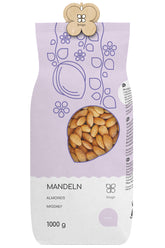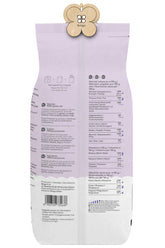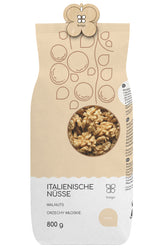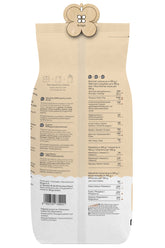Créatine – Faits et mythes sur un complément alimentaire populaire
Contenu
- La créatine, qu’est-ce que c’est ?
- Créatine – Fonctions dans le corps
- Types de créatine
- Nous démystifions les mythes sur la créatine
La créatine est une substance couramment utilisée comme complément alimentaire après tous les types de protéines de lactosérum . Il est particulièrement populaire auprès des personnes qui vont régulièrement à la salle de sport mais qui mènent également un mode de vie actif. Il n’est donc pas surprenant qu’il existe un groupe de partisans et d’opposants. Il existe également de nombreux mythes à ce sujet, dont certains sont absolument faux. Il convient de noter que ce supplément n’est pas une nouvelle découverte. Il est utilisé dans le sport depuis longtemps, mais n’est devenu populaire que récemment. Qu’est-ce qui est vrai à propos de la créatine ? Nous vous invitons à lire.
La créatine, qu’est-ce que c’est ?
Tout d’abord, il convient de définir ce qu’est réellement la créatine. Beaucoup seront peut-être surpris d’apprendre qu’il est présent naturellement dans notre corps et qu’il est produit par une série de processus chimiques. Cependant, c'est un nom plus courant. Il est composé de trois acides aminés : la méthionine, la glycine et l’arginine. Ce composé chimique a été découvert en 1832 et est également connu sous le nom d'acide bêtaméthylguanidinoacétique. Les plus grandes quantités se trouvent dans les muscles et les tendons. De plus, il remplit un certain nombre de fonctions nécessaires au bon fonctionnement de ces tissus, mais aussi de l’ensemble du corps.
Créatine – Fonctions dans le corps
La créatine est une substance chimique dont la fonction principale est de coordonner les contractions et les relaxations musculaires. De plus, il transporte l’ATP, le vecteur d’énergie le plus important du corps. Ceci est important car plus il y a d’ATP dans les muscles eux-mêmes, plus leur endurance, leur force de contraction et leur temps de travail efficace sont importants. Il peut également stimuler la synthèse de tous types de protéines et augmenter l’hydratation des cellules musculaires. Il convient de mentionner qu’il s’agit d’une caractéristique très positive car elle peut conduire à une croissance plus rapide de cette cellule et à sa force individuelle. La créatine influence également le taux de dégradation des glucides dans les muscles, augmentant ainsi les réserves énergétiques de ces organes. Cela leur permet de travailler plus longtemps, ce qui est très important pour les activités physiques plus longues telles que les marathons et autres sports d’endurance. Un lien a également été démontré entre la créatine et la myostatine, une protéine qui inhibe dans une certaine mesure la croissance de la masse musculaire. Non seulement cela limite son effet, entraînant une augmentation plus importante du tissu musculaire, mais cela stimule également la sécrétion de l'hormone IGF-1 dans le foie. Ceci est d’une grande importance, par exemple, parce que cette hormone a un effet anabolisant qui stimule également la croissance musculaire. Une autre propriété de la créatine est la réduction de l’acidification musculaire, notamment après un exercice physique intense. Cela signifie que nous ne ressentons pas autant de douleur, mais contribue également à leur régénération accélérée. Grâce à ces facteurs, il est possible d’intensifier l’entraînement et sa fréquence.
Types de créatine
Il existe de nombreux types de créatine elle-même ou de composés chimiques dans lesquels elle se trouve. Par exemple, on peut distinguer :
- Créatine monohydrate
- Malate de créatine _
- Citrate de créatine
- Phosphate de créatine
- Ester éthylique de créatine
Ces cinq formes sont les plus populaires et relativement faciles à acquérir, nous allons donc décrire brièvement chacune d’elles.
Créatine monohydrate – la forme la plus simple et la plus courante de cette substance chimique. Il s’agit simplement d’une combinaison de molécules de créatine avec des molécules d’eau sous forme de poudre ou de capsules. Son utilisation entraîne de nombreuses réactions anaboliques, une synthèse protéique, une augmentation du transport d’ATP vers les muscles et une réduction des effets secondaires des courbatures.
Le malate de créatine est un composé formé par la synthèse de monohydrate de créatine et d’acide malique . En raison de sa structure spécifique, qui équivaut à un acide hydroxycarboxylique, il a un effet beaucoup plus important sur l'ensemble du corps. Premièrement, il peut stimuler la sécrétion accrue d’insuline par le pancréas. Grâce à cette action, il en résulte une augmentation de l'absorption de la créatine, puisque son transport dépend de l'insuline. Le malate lui-même est le plus courant, également sous forme de poudre blanche. Ses propriétés sont similaires à celles du monohydrate, mais il existe quelques différences fondamentales. Le malate peut augmenter la capacité de nos muscles à stocker du glycogène et ainsi les remplir, mais aussi augmenter les performances. Il est intéressant de noter que l’acide malique est impliqué dans le cycle de Krebs et aide le corps à produire plus de molécules d’ATP. Cependant, la combinaison du monohydrate avec l’acide seul conduit à une solubilité accrue de ce composé chimique dans l’eau, le rendant ainsi beaucoup plus facile à absorber.
Citrate de créatine – cette forme n’est rien d’autre qu’une combinaison de molécules de créatine et d’acide citrique dans un rapport de 1:3. Ce composé a des propriétés similaires au monohydrate, mais est beaucoup plus soluble dans l’eau. Grâce à sa plus grande résistance aux environnements acides, sa stabilité est également plus élevée dans l'estomac. Cela entraîne une libération progressive de créatine et empêche la formation de créatinine, une forme de créatine pratiquement inutile.
Phosphate de créatine – en termes simples, il s’agit d’une forme phosphorylée de créatine. Cela signifie que les cellules de cette substance sont reliées entre elles par une forte liaison phosphate. Il est intéressant de noter que cette forme est produite par nos muscles. Il est ensuite stocké en eux et est destiné à leur fournir des réserves énergétiques considérables. Cela leur permet non seulement de travailler plus longtemps, plus intensément et plus efficacement, mais assure également une régénération suffisante après l'entraînement et une augmentation de la masse musculaire. De plus, l’achat d’une préparation est relativement difficile. Cela était dû au fait que sa biodisponibilité était extrêmement faible. Cependant, ces informations sont contredites par les données obtenues directement auprès des personnes prenant ce médicament. On dit qu'il est extrêmement efficace pour un entraînement de force à court ou modéré avec une intensité élevée. Il est difficile de déterminer l’exactitude de ces données, mais sur la base d’observations aussi extrêmes, on peut supposer que l’efficacité du phosphate de créatine dépend très probablement des caractéristiques individuelles.
Ester éthylique de créatine – c’est sans doute la forme la moins couramment utilisée. Il est produit par l'estérification de la créatine et de l'alcool éthylique. Le but de ce traitement est d’augmenter l’absorption de créatine par les muscles. Dans ce cas, l’hypothèse principale était de créer un composé avec de forts effets anabolisants et anti-cataboliques. De plus, son effet principal est d'augmenter la quantité de créatine phosphate dans les muscles, mais aussi la capacité de stockage des cellules musculaires elles-mêmes, leur permettant de stocker beaucoup plus d'eau et de glycogène. Il convient de noter que ce phénomène est appelé hypertrophie sarcoplasmique et signifie en pratique une augmentation de la force et de la masse musculaire dans une période de temps relativement courte. Bien entendu, les effets les plus importants sont observés au début de l’utilisation de ce composé chimique. Par la suite, les augmentations ne sont plus aussi importantes ni aussi rapides.
Nous démystifions les mythes sur la créatine
Nous savons déjà quel effet la créatine a sur notre corps. Il vaut donc la peine de discuter et de corriger légèrement les mythes et les affirmations les plus courants à ce sujet qui circulent sur Internet.
La prise de préparations contenant de la créatine entraîne une destruction rénale
C’est l’accusation la plus courante contre la créatine, mais aussi contre presque la plupart des suppléments riches en protéines. Il convient de noter que tous les compléments alimentaires de ce type, ainsi que le processus de fabrication lui-même, y compris les effets sur notre corps, sont contrôlés par l'Inspection supérieure de la santé. Si ces produits étaient même vaguement nocifs, ils ne seraient jamais autorisés à la vente. Bien sûr, nous parlons de personnes en bonne santé, mais l'utilisation de ce type de produit par des patients souffrant, par exemple, d'insuffisance rénale n'est pas recommandée. Il convient également de mentionner que presque tous les aliments contiennent des informations sur le dosage et les limites de consommation quotidienne. Il est donc évident que la consommation de grandes quantités de créatine a un impact sur notre santé. Cependant, ces effets secondaires ne sont pas dus à la substance elle-même, mais à notre négligence et à notre insouciance.
La prise de suppléments de créatine nécessite l'apport de grandes quantités de liquide
Le fait est que lorsque nous prenons des compléments contenant de la créatine, nous devons également augmenter notre consommation d’eau. Non, ces sommes ne sont pas aussi importantes qu’elles le paraissent. De plus, chaque corps est différent et les besoins en eau varient. Il est également important de veiller à ne pas fournir uniquement de l’eau à notre corps en buvant un verre. On le retrouve dans les soupes, les fruits, les légumes, la viande et même les œufs. Tous les rapports selon lesquels il est conseillé de boire même 5 litres d’eau tout en prenant des compléments alimentaires sont complètement absurdes et peuvent faire plus de mal que de bien. Il vaut donc la peine d’augmenter légèrement la quantité de liquide dans l’alimentation, mais pas dans des quantités aussi absurdes.
Le monohydrate de créatine est la pire forme de ce supplément
C’est un fait incontestable que le monohydrate de créatine est l’un des produits à base de créatine les plus abordables et les plus populaires. Cela ne veut pas dire que c’est la pire chose. De temps à autre, de nouvelles formes apparaissent et il n’est pas surprenant qu’elles soient décrites comme beaucoup plus efficaces et digestes. Malheureusement, ce prétendu avantage des nouveaux compléments alimentaires n’a été prouvé dans pratiquement aucune étude scientifique indépendante. De plus, de nombreuses études ont montré que le monohydrate est un bien meilleur choix que, par exemple, la créatine tamponnée ou estérifiée. De plus, il convient de noter qu’en raison de sa présence relativement longue sur le marché, il s’agit de la forme de créatine la mieux testée et la plus sûre. Cela conduit non seulement à des prix plus bas et à une disponibilité accrue, mais également à la confiance dans le produit que vous prenez.
L’effet de la créatine est en fait de remplir les muscles d’eau
Un mythe très souvent répété à propos de la créatine est que son effet se limite au gonflement des muscles. De plus, cet effet ne se produirait que pendant la supplémentation elle-même. Il s’agit d’une distorsion évidente de la vérité. Il convient de noter que même si la créatine provoque une rétention d’eau dans les muscles, ce n’est pas le seul effet de son utilisation. De plus, le glycogène et la phosphocréatine s’accumulent dans le tissu musculaire. Bien que ces valeurs diminuent considérablement après l’arrêt du supplément, tous les effets, tels qu’une augmentation de la force, de l’endurance et de la masse musculaire, sont permanents.
De nombreux nutriments bloquent l’absorption de la créatine
Parfois, nous rencontrons des informations selon lesquelles les graisses, le lait et même la consommation de suppléments contenant de la créatine à jeun peuvent entraîner une réduction drastique de l’absorption de la créatine. C’est inquiétant car de telles recommandations se retrouvent sur de nombreuses étiquettes de ce type de produit. Jusqu’à présent, il n’existe pratiquement aucune preuve à l’appui de l’idée d’éviter de consommer de la créatine avec les repas. Il convient également de noter qu’il est présent naturellement comme composant de nombreuses protéines que nous consommons chaque jour. De plus, il a été démontré que la consommation de créatine avec des glucides et des graisses peut augmenter considérablement l’absorption. Il est intéressant de noter que la créatine est un ingrédient courant dans de nombreux autres suppléments, notamment les suppléments de protéines ou de protéines-glucides. Par conséquent, le consommer avec d’autres nutriments n’est pas nocif, mais en réalité bénéfique.
Il convient de noter que la prise de suppléments à base de créatine n’est pas une garantie de résultats. Il peut favoriser le développement de la masse musculaire, de l’endurance et de la force. De plus, une formation et une nutrition appropriées sont nécessaires. De plus, la créatine elle-même est un composé d’origine naturelle et ne peut en aucun cas être considérée comme un stéroïde ou un remède miracle pour des effets d’entraînement étonnants. Mais pas pour moi, c'est très efficace et cela ne vaut pas la peine de répéter les nombreux mythes à ce sujet. Le facteur le plus important est simplement une utilisation prudente.
LE CHOIX DE L'ÉDITEUR
Amandes 1 kg BIOGO
- £11.00
£13.00- £11.00
- Prix unitaire
- / par
Noix 800 g BIOGO
- £8.00
£10.00- £8.00
- Prix unitaire
- / par
Mangue séchée bio 400 g BIOGO
- £10.00
- £10.00
- Prix unitaire
- / par
Mûres blanches séchées 500 g BIO
- £6.00
£7.00- £6.00
- Prix unitaire
- / par
Figues séchées bio 800 g BIOGO
- £27.00
- £27.00
- Prix unitaire
- / par
Gruau de sarrasin non décortiqué 1 kg BIOGO
- £3.00
£3.00- £3.00
- Prix unitaire
- / par
Noix de coco râpée bio 500 g BIOGO
- £9.00
- £9.00
- Prix unitaire
- / par
Flocons d'avoine bio 600 g BIOGO
- £4.00
- £4.00
- Prix unitaire
- / par
Noix de cajou bio 1 kg BIOGO
- £18.00
- £18.00
- Prix unitaire
- / par
Graines de chardon-Marie 1 kg BIOGO
- £4.00
- £4.00
- Prix unitaire
- / par









































































































































